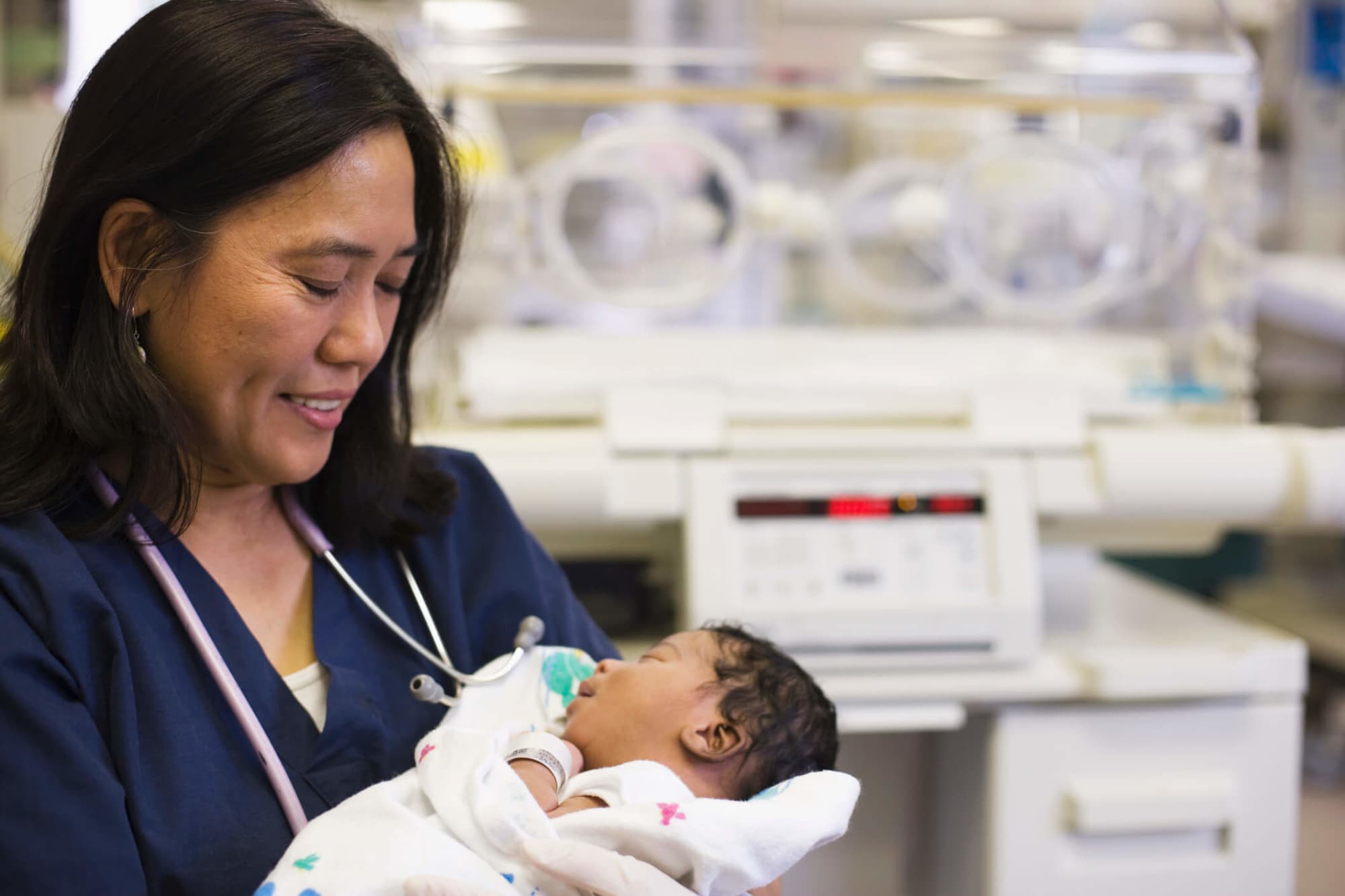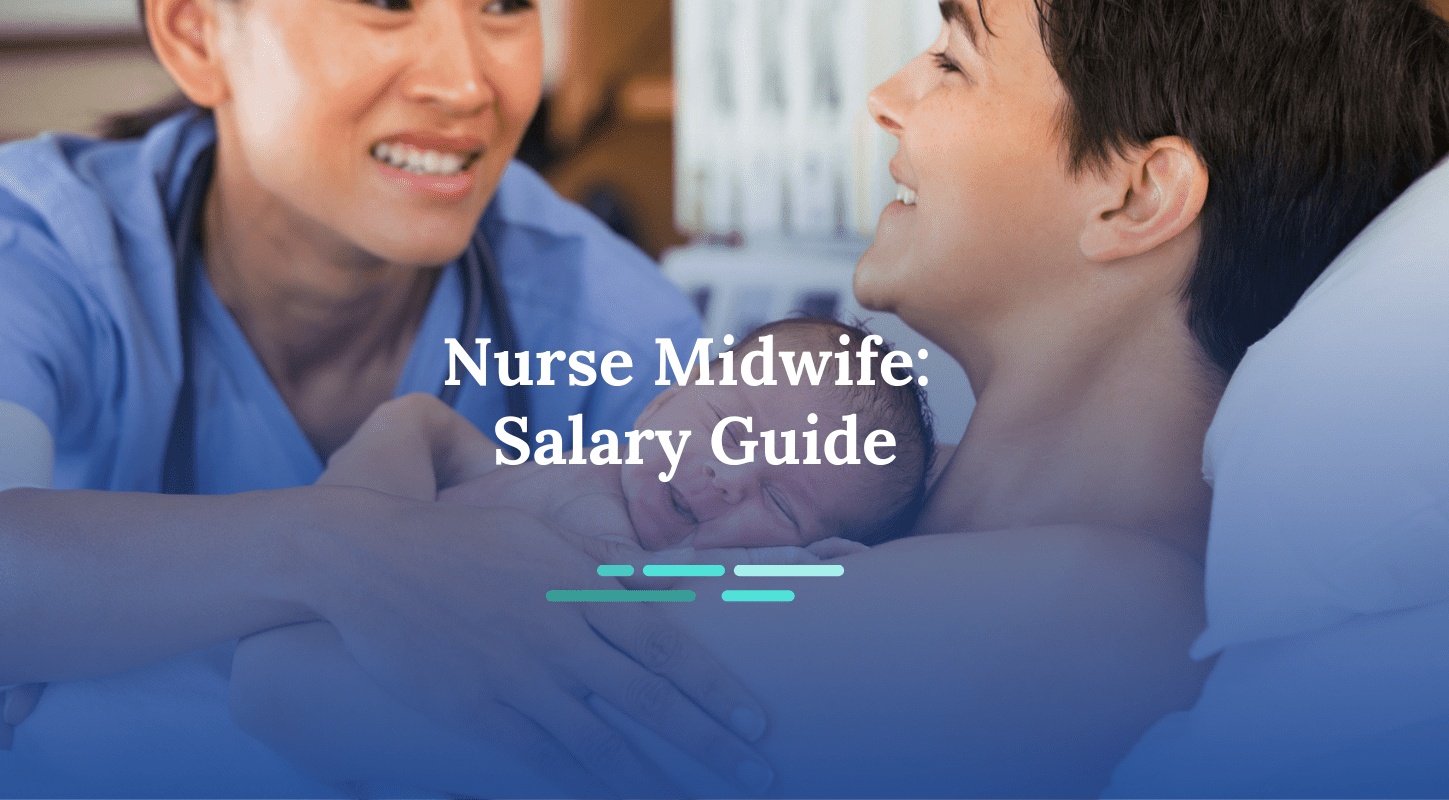At-Home Births vs. Hospital Births Compared

Are you ready to earn your online nursing degree?
 Credit: Halfpoint Images / Moment / Getty Images
Credit: Halfpoint Images / Moment / Getty ImagesIf you’re considering an at-home birth in the United States, there are several factors you may want to review to ensure your and your baby’s safety.
According to The American College of Obstetrics and Gynecology, of the 35,000 home births each year, nearly 25% are unplanned or unattended. Information and planning are essential to reduce your risk of an unplanned or unattended home birth.
In this guide, we’ll walk through the benefits and risks of home births vs. hospital births.
Are Home Births Safe?
There is no simple answer. Instead, several factors should be taken into account. Home births without a midwife or obstetrician attending are much more likely to be unsafe. Data from a study published in 2020 finds that planned home births were also less safe than hospital births even when attended by direct-entry midwives or certified nurse midwives.
The study shows, on average, the rate of infant death from 2010-2017 was four times higher for planned home births vs. hospital births.
Researchers point out the difference in safety between at-home and hospital births was not seen in other developed nations. Other countries have a more established midwifery system where home births are better integrated into the health system.
Also, in an earlier study, the research team found that many planned U.S. at-home births involved women who would not have qualified in countries with stricter at-home birth guidelines. These include risk factors such as obesity, age, and a history of a cesarean section.
Why Choose a Home Birth?
Intervention, such as a cesarean section, is less likely in low-risk women during a planned at-home birth. However, there is a need to better identify who qualifies for home births versus hospital births. Generally, low-risk women are much better candidates for home birth.
According to a study that analyzed birth outcomes, there was a 41% increase in home births from 2004 to 2010. Researchers found low-risk women had higher rates of vaginal birth without intervention. There was also no increase in adverse outcomes for low-risk women.
For instance, the cesarean rate was remarkably low in the group — 5.2% versus the national average of 31%. Low-risk women include those who:
Do not have medical diseases or conditions that may influence the birth outcome
Do not have a past history of serious complications in pregnancy
Have a single baby in the head-down position
Spontaneously go into labor at term
Data indicates that women who are moderate or high risk have better outcomes in a hospital. Low-risk women have similar rates of adverse outcomes as those who give birth in a hospital.
Popular Nursing Programs
Learn about start dates, transferring credits, availability of financial aid, and more by contacting the universities below.
Home Births vs. Hospital Births: Associated Risks
As planned home births have increased, researchers are evaluating the risks and benefits associated with home births versus hospital births. Although less intervention for low-risk women might be a positive outcome for planned home births, it is not always clear when interventions are necessary to prevent adverse outcomes.
There are potential risks at home or in the hospital. Some potential risks for a specific birth cannot be predicted.
Potential Risks of Home Births
Maternal Blood Transfusions
In a sample close to 79,730 women, research by Oregon Health and Science University found those who gave birth out of the hospital had a higher risk of postpartum transfusion. Researchers believe the transfusion was likely from a postpartum hemorrhage.
Women were more likely to receive a transfusion if they gave birth outside a hospital, gave birth more than three hours before transferring to a hospital, or had a cesarean section. However, another study in the U.K. using data from 1988 to 2000 found women who gave birth in the hospital had a greater risk of postpartum hemorrhage.
Low Apgar Scores
Apgar scores measure an infant’s heart rate, breathing, muscle tone, reflexes, and color at one and five minutes after birth. A low Apgar score indicates the baby needs help to maintain their heartbeat and breathing.
This score is used in studies comparing home births vs. hospital births. Some studies have found a greater number of low Apgar scores measured at five minutes in at-home births (without also considering the mother’s risk factors).
Neonatal Seizures
The neonatal period is the most vulnerable, especially within the first week of life. Sudden, abnormal, and excessive electrical activity in the brain occurring during the first 28 days are neonatal seizures. They may be the result of deficiency in the amount of oxygen reaching tissues, intracranial hemorrhage or infection, metabolic disturbances, or drug withdrawal.
The majority of research into home births versus hospital births have found no differences in deaths, Apgar scores, or neonatal intensive care unit (NICU) admission. Some, though, have found a higher rate of neonatal seizures (without evidence that the researchers separated between low- and high-risk women).
Potential Risks of Hospital Births
Hospital-Acquired Infections
The most common type of hospital-acquired infections (HAIs) are skin infections caused by methicillin-sensitive or methicillin-resistant Staphylococcus aureus. These can occur on the umbilical stump, nose, or groin and may not be evident until after discharge.
In the NICU, the most frequent types of HAIs are blood and urinary tract infections. These infections can threaten survival and developmental outcomes in the baby. Prevention is critical to avoid death or a lengthy hospital stay.
Perineal Lacerations/Vaginal Tears
Severe (third or fourth degree) perineal lacerations are a potential risk during hospital births. These are vaginal tears that occur when the birth progresses quickly and the vagina doesn’t have time to stretch. A third-degree tear involves the muscles of the anus and rectum, and a fourth-degree tear may extend into the lining of the anus or rectum.
Midwives may reduce your risk of a laceration using several techniques, including prebirth perineal massage, warm compresses over the perineum during birth, and slow and controlled birth of the baby’s head.
Interventions
There are a number of optional interventions doctors may use during a hospital birth that interferes with normal physiological processes. In some cases, these interventions are needed to prevent poor outcomes. In other cases, the healthcare professional may use them to control the situation.
These might include bed rest during labor, frequent electronic fetal monitoring, limited oral intake, more frequent vaginal exams, induction, “breaking the water” intentionally, and insertion of a catheter. These can lead to ineffective pushing, vaginal surgical cuts and tearing, instrumental vaginal birth, and a cesarean section.
Cesarean Sections
Since 1990, the rate of cesarean sections has tripled, beginning at 6% and rising to 21% in 2018. There are now more cesarean sections than vaginal deliveries in parts of southeast Europe, Latin America, and China.
Cesarean sections raise the potential risk of obesity and autoimmune diseases later in life. Although it can be lifesaving when medically necessary, the prevalence of morbidity and mortality in women is higher. It is also associated with uterine rupture, stillbirth, preterm birth, and ectopic pregnancy. Infants also have various exposures, like bacterial or hormonal, that might change how their body functions.
COVID-19’s Effects on Home Births
The COVID-19 pandemic has shifted the dynamics of healthcare, specifically home births vs. hospital births. Changing policies and reduced staffing, delayed surgeries, and no visitation raised concerns for those who were pregnant.
During the height of the pandemic, birthing partners couldn’t attend prenatal or ultrasound appointments and only one person —including the doula —could be present during labor and delivery. Fluctuating policy changes were one of the reasons some opted for a home birth during 2020.
COVID-19 also changed a new parent’s perspective of safety since sharing the hospital with ill patients increases the risk of contamination. The pandemic triggered a financial crisis as workers were laid off, businesses failed, and mounting debt caused researchers to look at cost-effective healthcare measures. One economic analysis found that if 10% of hospital births occurred in birthing centers or at home, the healthcare system could save $11 billion per year “without compromising safety.”
Nurses and Birth Settings
In hospital births, pregnant individuals are cared for by labor and delivery nurses during labor, birth, and immediate postpartum. These nurses monitor a pregnant person’s condition and provide psychological and emotional support. Nurses are not licensed to assist deliveries outside of the hospital.
Certified nurse midwives also provide care during labor and delivery. They assess, diagnose, and treat pregnant individuals toward a healthy delivery. Certified nurse midwives may manage a birth at home, birthing center, or hospital.
It is important to weigh the pros and cons of home births vs. hospital births as you plan. According to recent research, poor outcomes in home births have a similar rate to hospital births when the person is low risk. Before making a decision, talk with your healthcare professional about your options and any potential risks.
Frequently Asked Questions: At-Home Births vs. Hospital Births
Are hospital births safer than home births?
Safety is most important during labor and delivery. Whether a hospital or home birth is safer for you is based on specific risk factors such as obesity, older age, and history of a prior cesarean section. There are risks in either situation. The decision you make should rest on your risk level, access to an experienced midwife, and quickly available transport to a hospital.
What are the advantages of a home birth?
Those who give birth at home express greater comfort and satisfaction with the experience. There is a reduced risk of interventions that may not be immediately necessary, such as induction, forcing the amniotic water to “break,” frequent electronic fetal monitoring, and more frequent vaginal exams. Home births have a much lower rate of cesarean sections which might have additional risks.
What are the disadvantages of a home birth?
Pregnant individuals who give birth at home have a higher risk of postpartum hemorrhage and blood transfusions. When the maternal risk level is not adequately assessed for a home birth, it may increase the risk of low Apgar scores, neonatal seizures, and the rate of neonatal mortality.
Can I have my baby at home without a midwife?
A certified nurse midwife has at least eight years of education to provide safe care during home births. Although birthing is a natural process, there are many ways to ensure the experience is healthy. For instance, certified nurse midwives can quickly recognize when immediate medical assistance is needed.
Reviewed by:

Debra Rose Wilson, Ph.D., MSN, RN, IBCLC, AHN-BC, CHT
Debra Rose Wilson is an associate professor and holistic healthcare practitioner. She graduated from Walden University with a Ph.D. and teaches graduate-level psychology and nursing courses. Her expertise also includes obstetrics and breastfeeding. Wilson is the managing editor of a peer-reviewed international journal. She enjoys being with her Tibetan terrier, Maggie.
Wilson is a paid member of our Healthcare Review Partner Network. Learn more about our review partners.
You might be interested in

Meet a Certified Lactation Counselor
Certified lactation counselors work with mothers, newborns, and family members advising and educating them about breastfeeding. Read on for information on how to become a lactation counselor.

How Much Do Nurse Midwives Make?
Interested in becoming a certified nurse midwife? This guide explains everything you need to know about CNM salaries, including how location, work setting, and experience affect pay.

Obstetrics Nurse Career Overview
Learn how to become an obstetrics nurse or obstetrics nurse practitioner, how much OB/GYN nurses make, and OB/GYN nurse salaries.